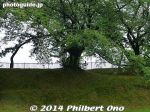 Image search results - "kano-juku" Image search results - "kano-juku" |

Kano-juku was the 53rd station or lodging/post town of the Nakasendo Road. Hiroshige's print of Kanō-juku was part of The Sixty-nine Stations of the Kiso Kaidō series. Kano Castle can be seen. Short walk south of JR Gifu Station.
|
|

Not much is left except for a few markers indicating the location of the Waki Honjin, Honjin, and other features. Tenmangu Shrine and Kano Castle's stone walls are the major sights.
|
|

Map of Kano-juku in English. Gifu Station is on the upper right, and Kano Castle is on the left.It had the Honjin, Waki-Honjin, and 35 lodges. The population was 2,728.
|
|

Signs
|
|

Nakasendo Road in Kano-juku.
|
|

Nakasendo Road in Kano-juku.
|
|

Marker for Kano-juku's Waki Honjin. 脇本陣
|
|

Marker for Kano-juku's Waki Honjin. 脇本陣
|
|
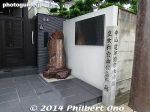
Marker for Kano-juku's Honjin where Princess Kazunomiya once stayed on Oct. 26, 1861 on her way from Kyoto to Edo to marry Shogun Tokugawa Iemochi. 本陣
|
|

Monument for the poem Princess Kazunomiya composed while in Kano-juku. This is her handwriting. Monument was built in 2002.
|
|

Marker for Kano-juku's Honjin. 本陣
|
|

About Princess Kazunomiya's poem and monument.
|
|

Way to Kano Tenmangu Shrine.
|
|

Entrance to Kano Tenmangu Shrine. 加納天満宮
|
|
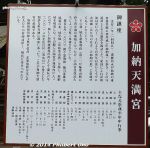
About Kano Tenmangu Shrine. 加納天満宮
|
|

Wash basin.
|
|

Koma-inu lion dog.
|
|

Kano Tenmangu Shrine's Haiden worship hall. 拝殿
|
|

Kano Tenmangu Shrine.
|
|

Kano Tenmangu Shrine worships Tenjin, aka Sugawara no Michizane, the god of scholarly learning. This is the Honden hall. 本殿
|
|

Kano Tenmangu Shrine office.
|
|

Kano Tenmangu Shrine's ema prayer tablet.
|
|
|

Monument marking the birthplace of Gifu's Boy Scouts.
|
|

Kano used to have nine festival floats, but all except one was destroyed by World War II bombing of Gifu in 1945. The shrine buildings were also destroyed.
|
|

Kano-juku road marker.
|
|

Nakasendo road marker at Kano-juku. "Go left for Nakasendo." Originally built in 1750. 加納宿 中山道道標
|
|

About the Nakasendo road marker at Kano-juku. It was at the intersection of the Nakasendo and Gifu Roads.
|
|

Spot where the Kosatsu bulletin board was in Kano-juku. It was originally on a stone foundation. This spot used to have many people passing by as it was near the castle's front gate. 加納宿 高札
|
|

About the Kosatsu bulletin board in Kano-juku. It posted local laws and regulations and other official notices from the local ruler. 高札
|
|

Kosatsu bulletin board was at one end of this bridge over a small river.
|
|

Road directions and map in English in Kano, Gifu.
|
|

Another road marker. "Go left for Kyoto"
|
|

Former Kano Town Hall. 旧加納町役場
|
|
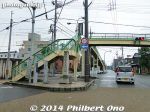
Marker for a gate at Kano Castle.
|
|

Marker for a gate at Kano Castle.
|
|

Kano Castle parking lot.
|
|

About Kano Castle. As ordered by Shogun Tokugawa Ieyasu, it was built soon after the Battle of Sekigahara in 1600. Parts from Gifu Castle were used to build Kano Castle.
|
|

In 1601 when Shogun Tokugawa Ieyasu dismantled Gifu Castle, he ordered Kano Castle to be constructed here south of Gifu Castle.Kano-juku then thrived as a castle town and became Nakasendo's fifth largest shukuba lodging town.
|
|

Kano Castle as it looked originally in Gifu. 加納城
|
|

Kano Castle as it looked originally on a map. All the moats were later filled in. 加納城
|
|
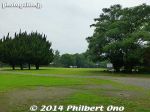
Kano Castle has a large grassy area surrounded by stone walls. No buildings. 加納城
|
|
|

Kano Castle stone foundation.
|
|
|
|
|
|
|
|
|
|
|
|

About Kano Castle's Honmaru stone foundation built in the early 1600s.
|
|
|
|

Kano Castle stone walls. Near JR Gifu Station's south exit.
|
|

Kano Castle stone walls.
|
|
|
|

Another entrance to Kano Castle. Thanks to my friend Satomi for driving me around Kano.
|
|
|
|


















































